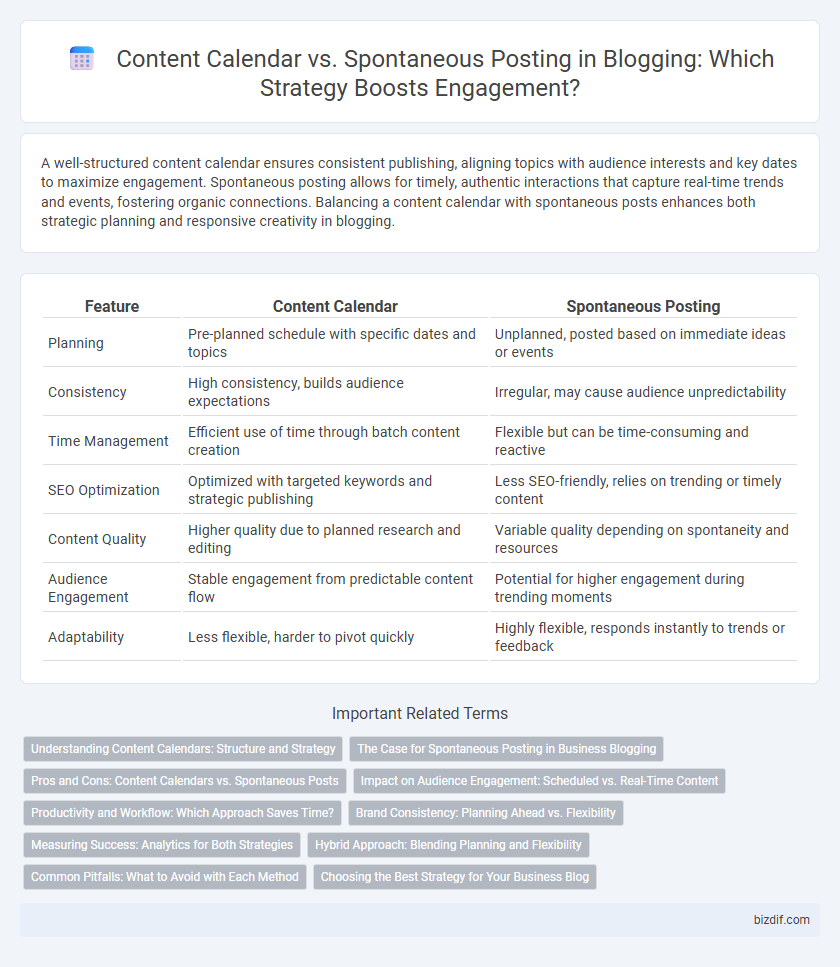A well-structured content calendar ensures consistent publishing, aligning topics with audience interests and key dates to maximize engagement. Spontaneous posting allows for timely, authentic interactions that capture real-time trends and events, fostering organic connections. Balancing a content calendar with spontaneous posts enhances both strategic planning and responsive creativity in blogging.
Table of Comparison
| Feature | Content Calendar | Spontaneous Posting |
|---|---|---|
| Planning | Pre-planned schedule with specific dates and topics | Unplanned, posted based on immediate ideas or events |
| Consistency | High consistency, builds audience expectations | Irregular, may cause audience unpredictability |
| Time Management | Efficient use of time through batch content creation | Flexible but can be time-consuming and reactive |
| SEO Optimization | Optimized with targeted keywords and strategic publishing | Less SEO-friendly, relies on trending or timely content |
| Content Quality | Higher quality due to planned research and editing | Variable quality depending on spontaneity and resources |
| Audience Engagement | Stable engagement from predictable content flow | Potential for higher engagement during trending moments |
| Adaptability | Less flexible, harder to pivot quickly | Highly flexible, responds instantly to trends or feedback |
Understanding Content Calendars: Structure and Strategy
Content calendars provide a structured framework that organizes publishing schedules, ensuring consistent and strategic content delivery tailored to target audience engagement patterns. They enhance content planning by aligning posts with marketing goals, seasonal trends, and platform algorithms, maximizing reach and impact. Spontaneous posting may capture real-time opportunities but lacks the predictive analytics and optimization benefits integral to a well-crafted content calendar strategy.
The Case for Spontaneous Posting in Business Blogging
Spontaneous posting in business blogging fosters authentic engagement by capturing real-time trends and audience sentiments, which can lead to higher interaction rates and stronger brand loyalty. This strategy allows businesses to quickly respond to industry developments and customer feedback, creating a dynamic and relevant content stream. Incorporating spontaneous posts alongside a content calendar can enhance flexibility and keep the blog fresh and responsive to market changes.
Pros and Cons: Content Calendars vs. Spontaneous Posts
Content calendars enhance blog consistency, improve time management, and align posts with marketing goals, but they can limit flexibility and spontaneity. Spontaneous posting allows real-time engagement and trending topic coverage but risks irregular updates and reduced content quality. Balancing structured planning with creative freedom optimizes audience retention and content relevance.
Impact on Audience Engagement: Scheduled vs. Real-Time Content
A content calendar boosts audience engagement by ensuring consistent, timely posts that align with user behavior patterns, leading to higher retention and predictability. Spontaneous posting leverages real-time events and trending topics, driving immediate interaction and organic reach through relevance and novelty. Brands balancing scheduled workflows with spontaneous content capture maximize engagement by combining strategic planning with authentic, context-driven responsiveness.
Productivity and Workflow: Which Approach Saves Time?
A content calendar streamlines productivity by organizing posts ahead, reducing decision fatigue and ensuring consistent workflow efficiency. Spontaneous posting offers flexibility but often disrupts time management, leading to last-minute stress and potential workflow bottlenecks. Structured scheduling with a content calendar typically saves more time by allowing batch content creation and strategic planning.
Brand Consistency: Planning Ahead vs. Flexibility
A content calendar ensures brand consistency by enabling strategic planning and uniform messaging across all posts, reinforcing brand identity over time. Spontaneous posting allows flexibility to engage with trending topics and real-time audience interactions but risks inconsistent tone and scheduling. Balancing a structured content calendar with moments of spontaneity captures both reliability and relevance in brand communication.
Measuring Success: Analytics for Both Strategies
Measuring success in blogging requires analyzing key metrics such as engagement rates, website traffic, and conversion rates for both content calendar and spontaneous posting strategies. Content calendars allow for consistent tracking of scheduled posts, providing clear data on audience retention and growth patterns. In contrast, spontaneous posts often generate immediate engagement spikes, offering insights into trending topics and real-time audience preferences through social media analytics and on-the-fly performance monitoring.
Hybrid Approach: Blending Planning and Flexibility
A hybrid approach to blogging combines the strategic structure of a content calendar with the creative freedom of spontaneous posting, enhancing audience engagement and content relevance. Utilizing a content calendar ensures consistent publishing and alignment with marketing goals, while spontaneous posts capitalize on trending topics and real-time interaction. This balance optimizes reach and maintains authenticity, making the blog adaptable and dynamic in fast-changing digital landscapes.
Common Pitfalls: What to Avoid with Each Method
Content calendar pitfalls include inflexibility, leading to outdated or irrelevant posts if current trends are ignored, and over-planning, which can stifle creativity and authenticity in blogging. Spontaneous posting risks inconsistency, reducing audience engagement and SEO effectiveness, and may result in off-topic or poorly researched content that damages credibility. Balancing scheduled content with room for timely updates avoids stagnation while maintaining relevance and quality in blog strategy.
Choosing the Best Strategy for Your Business Blog
A content calendar streamlines blog management by scheduling posts around key dates and targeted themes, enhancing consistency and audience engagement metrics. Spontaneous posting allows for agile content creation, capturing trending topics and real-time audience interests, which can boost immediate traffic and relevance. Balancing scheduled planning with flexibility ensures optimal SEO performance and sustained growth tailored to your business goals.
Content calendar vs Spontaneous posting Infographic

 bizdif.com
bizdif.com